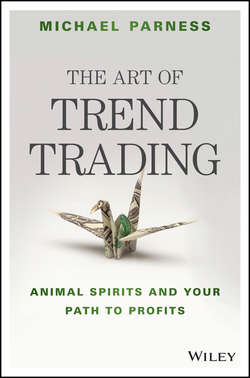The Art of Trend Trading

Реклама. ООО «ЛитРес», ИНН: 7719571260.
Оглавление
Parness Michael. The Art of Trend Trading
Foreword
Chapter 1. Wishing You a Slow Rise
Chapter 2. Bear with Me
Chapter 3. Breakout City and Riding the Horse to Gains
Chapter 4. Power Trading
Chapter 5 $12,500 to $3.8 Million
Chapter 6. Options (Pretty) Basic Primer
Chapter 7. Trading Options
Chapter 8. Trading Gaps Animal Spirit Guide (Stalking, Leopard)
Chapter 9. My Favorite Animal Spirits
Chapter 10. Trading Gaps Using Technical Analysis
Chapter 11. News Rules! Trading News
Chapter 12. Trading Laggards
Chapter 13. Trends Are Your Friends
Chapter 14. Finding Your Own Animal Spirit
Chapter 15. Zen and the Art of Rich
Chapter 16. What Animal Spirit Are You?
About the Author
WILEY END USER LICENSE AGREEMENT
Отрывок из книги
Michael Parness and I come from very different parts of the financial world, and though very different, we are complementary in many ways. I got started in trading in the late 1990s. I had just come back from a summer in Spain and a few different study-abroad programs. While studying (partying; – )) in Europe, I had started to trade and monitor my accounts online. When I got back to New York and started graduate school, I also started a job as a head hunter in New York City. In 1998, it did not take me long to figure out where the best-paying jobs were in NYC – Wall Street. As a head hunter, I knew that there was one company that was hiring more people than any other firm. It was an Internet online trading company. So I sent myself out for an interview there, and sure enough, I got a job offer.
So my trading experience started more from the direction of being a person on a professional trading desk. Mind you, when I got started at Precision Edge Securities (later, edgetrade.com) in 1999, I was not a licensed broker. I had to cram to pass my series 7 in January 2000. Professional trading at that time was mainly a scalping style, widely known as SOES trading, because we used systems like SOES, Select Net, and Instinet to route our orders. I traded and helped run a trading desk where there was a mix of retail brokers trading for their clients (we at the trading desk executed their orders), retail trader SOES scalping, and momentum trading. For the retail brokers, I was more like a foot soldier. I worked and executed orders, and that was my focus. It was very short term, and I had no idea why the clients or the brokers were buying or selling. My performance was measured entirely by my execution price versus VWAP (volume-weighted average price). As for the day traders, well, I was one of them when not trading a client order.
.....
This will allow you to identify how your strengths have already served you, whether it's as an old-time successful trader or a plumber. I think most people can succeed at trading if they have some of the main attributes we are discussing, or they can learn to train themselves to attain those attributes: Discipline, money management, and overcoming adversity are three of the main ones.
In this step, act as if you are interviewing for a job with me for a trader position. How would you sell me without completely out-and-out lying?
.....